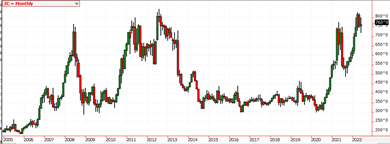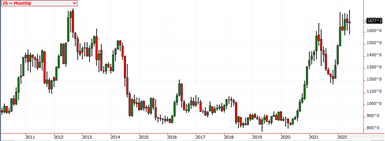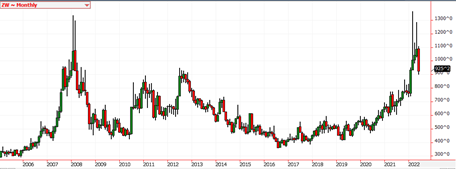
Market advisers have used the line "Don't fight the Fed" for more than a decade. This was due to the easy monetary policy the Federal Reserve put into play to stimulate the economy after the housing bubble bust in 2008. It took time, but the economy recovered from the bubble burst. The stock market rallied to all-time highs while inflation was tamed.
When Covid hit the economy two-and-a-half years ago, the easy monetary policy of the Fed, combined with three rounds of stimulus Congress pushed out, sent the stock market soaring but also unleashed inflation.
This brought massive amounts of money into the commodity markets, as history suggests the way to invest during inflationary times is to buy commodities. Investors were rewarded with their investments as commodities outperformed every other asset in 2021. Russia's war in Ukraine turbocharged energy and food prices even more. Soft red wheat, corn, and soybeans traded though or just came up short of their all-time highs.



Reverse course
The Fed is now reversing course, trying to stuff the inflation genie back into the bottle. To do this, they have started to raise the Fed fund rates. They will keep raising rates until demand for goods is curtailed. This, in turn, drives down the price of commodities due to the lack of demand.
Here's the tricky part. If the demand for products drops by too much, the risk to the economy is a recession. A recession is a temporary economic decline resulting in reduced trade and industrial activity. It is generally identified by a GDP fall in two successive quarters or longer.
The Fed is the invisible hand that guides the economy, and they tend to get the economy to move in the direction they want. Hence, the "Don't fight the Fed" slogan was born.
With the Fed doing everything in its power to curtail demand for goods, it is telling investors/speculators they are working against trades that are in place to be rewarded if commodity prices go higher.
Funds liquidate positions
In recent weeks we have seen funds liquidate positions, and we look for funds or speculators to continue to unwind their long positions in the commodity market as long as the current Fed policy is in place.
With inflation trade ending, grain traders will have to rely on supply issues and traditional demand from domestic and export business to be the driver behind price rallies. The Quarterly Grain Stocks report (released at the end of the month) will give us a better handle on the supplies we have on hand. The acreage number on the Acreage report will give us a better idea of the potential for the upcoming crop.
The stocks report could potentially give the trade the biggest surprise. The average trade estimate has June 1 corn stocks at 4.343 billion bushels. Compared to one year ago, June 1 stocks were at 4.11 billion bushels. The wide range of estimates (4.095 billion bushels to 4.474 billion bushels) shows how uncertain the industry is with supplies on hand.
The cash grain market has been on fire across much of the country, suggesting that producers are holding tight to old-crop supplies despite seeing all-time highs, or there isn't as much grain around as USDA has previously suggested.
As for the report's acreage portion, the trade's range for corn aces is 88.400 million to 91.000 million, with the industry average guess at 89.861 million acres. The March corn estimate was 89.490 million acres.
The trades range of forecasts for soybeans ranges from 88.735 million to 92.375 million, with the average guess at 90.446 million acres. In March, USDA reported soybean acres at 90.955 million acres.
What could happen
If the acreage numbers come in near the average guess, we believe it will not have that big of an impact on the balance sheet, and the trade's attention will shift to the weather pattern coming out of the three-day July 4 weekend as lost yield will have a much more significant impact on the overall crop size.
If the average national corn yield dropped five bushels from the current working national yield of 177 bushels per acre (which will tie the best national yield ever), the carry-out would drop below 1 billion bushels using the trade average acreage estimate, and leaving demand unchanged from the current forecast.
Soybean ending stocks could be cut by 50% or more from current estimates if the national yield is cut by only two bushels off the current working trend yield of 50.5 bushels per acre. This is even if we see a slight increase in acres at the trade expects.
The next few weeks tend to be the most volatile of the year as trade prices in the results of the Quarterly Grain Stocks and Acreage report as well as the forecast during the critical pollination period. The hotter and drier the forecast, the more volatile the trade is likely to be too.
If you have questions, don't hesitate to contact me directly at 815-665-0461 or anyone on the AgMarket.Net team at 844-4AGMRKT.
Reach Jim at 815-665-0461, [email protected] or on Twitter: @jpmccormick3.
The risk of loss in trading futures and/or options is substantial and each investor and/or trader must consider whether this is a suitable investment. AgMarket.Net is the Farm Division of John Stewart and Associates (JSA) based out of St Joe, MO and all futures and options trades are cleared through ADMIS in Chicago IL. This material has been prepared by an agent of JSA or a third party and is, or is in the nature of, a solicitation. By accepting this communication, you agree that you are an experienced user of the futures markets, capable of making independent trading decisions, and agree that you are not, and will not, rely solely on this communication in making trading decisions. Past performance, whether actual or indicated by simulated historical tests of strategies, is not indicative of future results. Trading information and advice is based on information taken from 3rd party sources that are believed to be reliable. We do not guarantee that such information is accurate or complete and it should not be relied upon as such. Trading advice reflects our good faith judgment at a specific time and is subject to change without notice. There is no guarantee that the advice we give will result in profitable trades. The services provided by JSA may not be available in all jurisdictions. It is possible that the country in which you are a resident prohibits us from opening and maintaining an account for you.
The opinions of the author are not necessarily those of Farm Futures or Farm Progress.
About the Author(s)
You May Also Like






